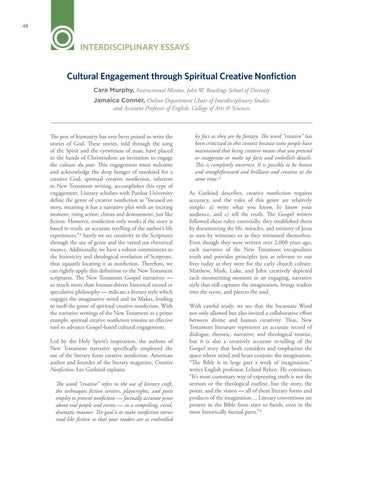48
INTERDISCIPLINARY ESSAYS
Cultural Engagement through Spiritual Creative Nonfiction Cara Murphy, Instructional Mentor, John W. Rawlings School of Divinity Jamaica Conner, Online Department Chair of Interdisciplinary Studies and Assistant Professor of English, College of Arts & Sciences
The pen of humanity has ever been poised to write the stories of God. These stories, told through the song of the Spirit and the eyewitness of man, have placed in the hands of Christendom an invitation to engage the culture du jour. This engagement must welcome and acknowledge the deep hunger of mankind for a creative God; spiritual creative nonfiction, inherent in New Testament writing, accomplishes this type of engagement. Literary scholars with Purdue University define the genre of creative nonfiction as “focused on story, meaning it has a narrative plot with an inciting moment, rising action, climax and denouement, just like fiction. However, nonfiction only works if the story is based in truth, an accurate retelling of the author’s life experiences.”1 Surely we see creativity in the Scriptures through the use of genre and the varied use rhetorical nuance. Additionally, we have a robust commitment to the historicity and theological revelation of Scripture, thus squarely locating it as nonfiction. Therefore, we can rightly apply this definition to the New Testament scriptures. The New Testament Gospel narratives — so much more than human-driven historical record or speculative philosophy — indicate a literary style which engages the imaginative mind and its Maker, lending to itself the genre of spiritual creative nonfiction. With the narrative writings of the New Testament as a prime example, spiritual creative nonfiction remains an effective tool to advance Gospel-based cultural engagement. Led by the Holy Spirit’s inspiration, the authors of New Testament narrative specifically employed the use of the literary form creative nonfiction. American author and founder of the literary magazine, Creative Nonfiction, Lee Gutkind explains The word “creative” refers to the use of literary craft, the techniques fiction writers, playwrights, and poets employ to present nonfiction — factually accurate prose about real people and events — in a compelling, vivid, dramatic manner. The goal is to make nonfiction stories read like fiction so that your readers are as enthralled
by fact as they are by fantasy. The word “creative” has been criticized in this context because some people have maintained that being creative means that you pretend or exaggerate or make up facts and embellish details. This is completely incorrect. It is possible to be honest and straightforward and brilliant and creative at the same time.2 As Gutkind describes, creative nonfiction requires accuracy, and the rules of this genre are relatively simple: a) write what you know, b) know your audience, and c) tell the truth. The Gospel writers followed these rules; essentially, they established them by documenting the life, miracles, and ministry of Jesus as seen by witnesses or as they witnessed themselves. Even though they were written over 2,000 years ago, each narrative of the New Testament encapsulates truth and provides principles just as relevant to our lives today as they were for the early church culture. Matthew, Mark, Luke, and John creatively depicted each mesmerizing moment in an engaging, narrative style that still captures the imagination, brings readers into the scene, and pierces the soul. With careful study, we see that the Incarnate Word not only allowed but also invited a collaborative effort between divine and human creativity. Thus, New Testament literature represents an accurate record of dialogue, rhetoric, narrative, and theological treatise, but it is also a creatively accurate re-telling of the Gospel story that both considers and emphasizes the space where mind and heart conjoin: the imagination. “The Bible is in large part a work of imagination,” writes English professor, Leland Ryken. He continues, “It’s most customary way of expressing truth is not the sermon or the theological outline, but the story, the poem, and the vision — all of them literary forms and products of the imagination… Literary conventions are present in the Bible from start to finish, even in the most historically factual parts.”3
